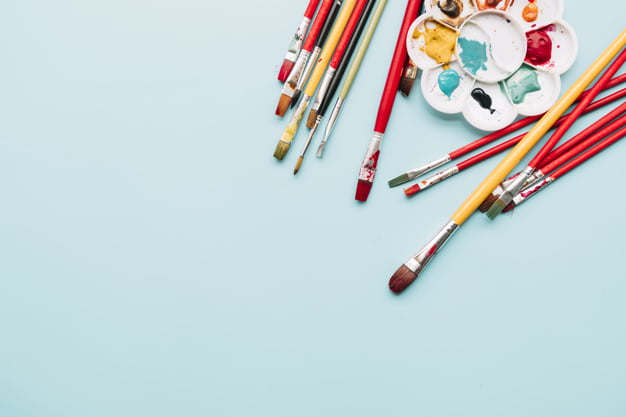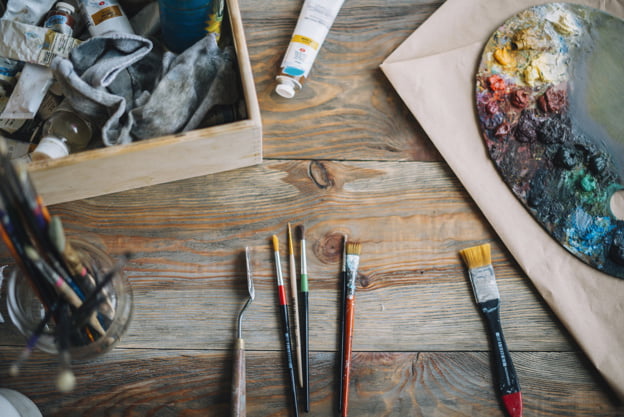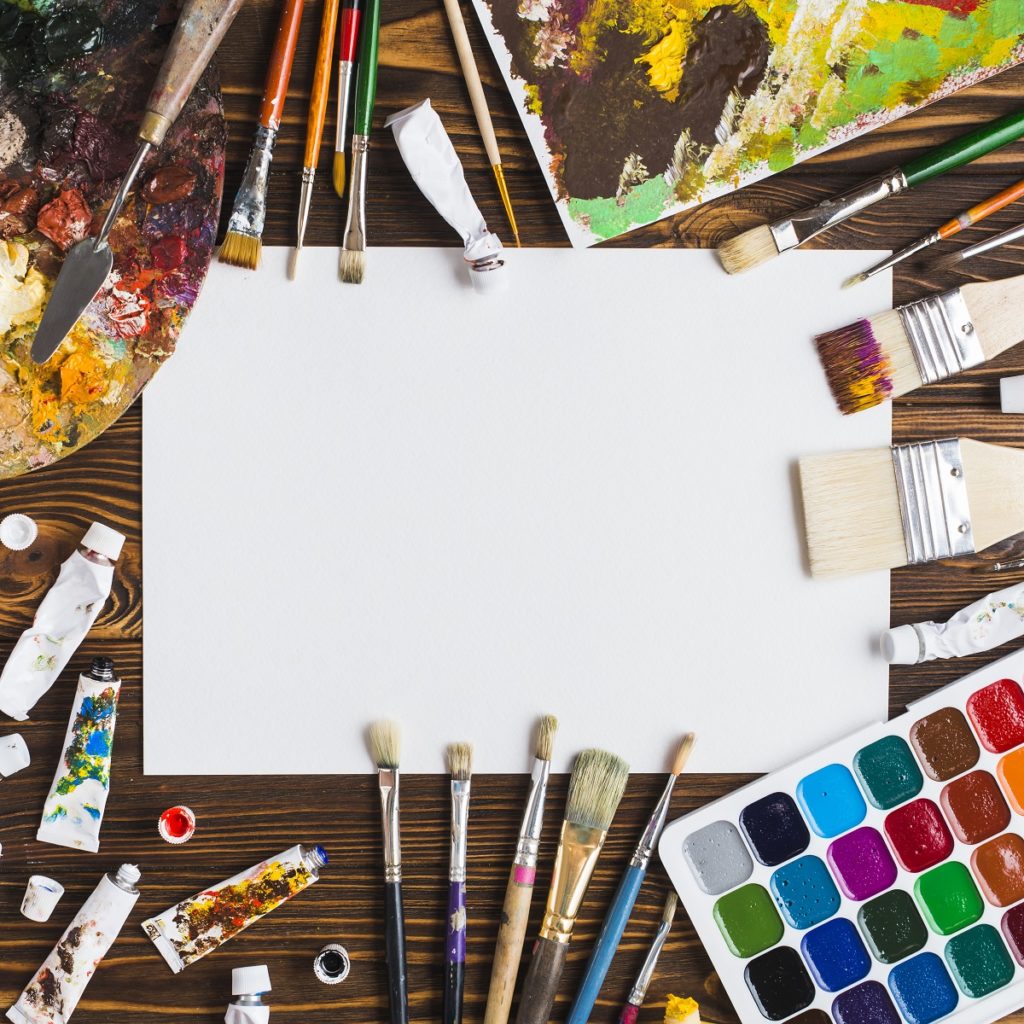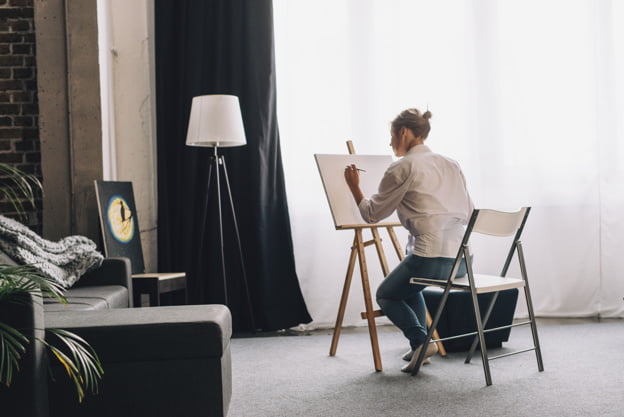The studio is like a place of worship for an artist. It is the home of an artist’s creative prowess. What are the essential materials that complete a studio?

As painting materials can differ slightly based on the type of paint in question, we want to list out all the acrylic painting materials needed in the studio. Acrylic paint is being used extensively by artists – beginners as well as professionals.
We have included ten of the most important materials that you would want to have in your studio. We have also explained the importance, uses, and benefits of each of these materials to give you a complete picture of an ideal studio, complete with acrylic painting materials.
Acrylic Painting Materials

We wanted to list out not only the commonly used elements that are essential for the very act of painting but also some other things that can make your life in the studio much more comfortable and hassle-free. Read on to know what we think are necessary materials for acrylic painting:
As a general rule of thumb, it is vital that you first understand what your short-term goal is.
People who are experts or experienced professionals in the field will want to display their paintings at exhibitions or local galleries to sell them. People who are new to the field or casual hobbyists will not have their paintings displayed before a large audience and will not be making money from it.
How is that important? Your studio will differ substantially depending on whether you are a beginner or a professional. Likewise, the materials you need in the studio will also vary.
A list of essential materials for acrylic painting will include paint! But what kind of paint should you keep in your studio? There are hundreds of varieties of acrylic paint with different prices available in the market.
While it is preferable to buy top-notch artist-grade paint, it is not the ideal option for everyone.
If you are relatively new to painting or take it as a hobby, you would not want to spend a lot of money on materials for your studio. Buying student-grade paints or sampler packs is advisable in this scenario. These paints are inexpensive compared to artist-grade paints, but they get the job done.
It does not require rocket science to understand that any professional or expert artist will not want to compromise on any of their painting materials. If you idolize Picasso or have an audience that scrutinizes every brush stroke, every dash of color that you put on a canvas, then you should not go for anything less than best-in-industry artist-grade acrylic paints.
-
Go for Inexpensive Brushes Initially
Paints and paintbrushes are like bread and butter for artists. No matter what type of an artist you are, how much experience you have in the art, what kind of art you create – you will need paint and brushes. Having addressed the first half of those prerequisites already, it is time to talk about paintbrushes.
All types of brushes are available in the market – varying thickness, bristle softness, length and more. And depending on the effect you are trying to achieve on the canvas, you will likely be using a wide range of paintbrushes over time. But how do you stock up brushes in your studio? How much should you ideally spend on this material?
Everything has its pros and cons. The quick-dry characteristic of acrylic paints makes it appealing to a lot of new and young artists as it saves substantial time. However, the same wreaks havoc on paintbrushes. Unlike oil paint which can take multiple days to dry completely, acrylic paint dries in less than an hour.
Removing dried up paint from the bristles of a brush can prove to be a nightmare. To cut a long story short, you are most likely to ruin some paintbrushes when using acrylic paint, especially in your initial painting days. So it does not make sense for you to buy expensive brushes for your studio.
Buying starter packs of brushes and reasonable yet efficient alternatives to high priced premium paintbrushes will save you a lot of money. If your favorite brush gets ruined and you know you did not spend a fortune on it, it gets easier to throw it away. When you get used to acrylic paint, you can switch to costlier brushes without a frown.

-
Keep Rugs or Blankets
Not only does acrylic paint dry fast, but it is also nearly permanent. It will not take a lot of effort to find a lot of videos of artists trying to remove hardened acrylic paint from their clothes or studio carpet. You might face a situation where you have spilled some paint accidentally, and it just won’t go away.
This one is more of a precautionary material, and though you do not need it to be able to carry out your painting work, it is an effective way of maintaining your studio. You should have a rug or a blanket on the studio floor at all times. It is all about protecting your surroundings.
We are not saying that it is impossible to get rid of acrylic paint stains from your studio floor, but it is rewarding to have preventive measures that ultimately allow you to focus on painting rather than cleaning.
Another benefit you can derive from having rugs or blankets on the floor is the added comfort when you have to work through a time-taking, detailed painting. We would recommend you to cover other surrounding surfaces as well with blankets and not just the studio floor. It takes only one slip of your wrist to spill paint away from the canvas and on to some other surface.
Using old papers on the floor is an alternative approach that solves the said concern if you are comfortable with the occasional crunch when you walk around the studio.
Gone are the days when paintings were restricted to paper. If anything, modern art has taught us to have an open mind. Artists use all kinds of surfaces today to bring their paintings to life. That’s where acrylic paint is an artist’s go-to option – it can adhere to nearly any surface.
Whether you are painting on metal, wood, plastic, cardboard, glass, or any other unconventional surface, you can safely use acrylic paints. Of course, you can use acrylic paint on the conventional cotton and linen canvases as well.
If you haven’t used acrylic paint before or you are relatively new to the art of painting, you should first get some practice on the traditional paint surfaces – paper and canvas. If you are a veteran, you have probably used various surfaces.
An important point we ought to mention is that no matter what surface you plan to use and stock up in your studio, you would want to get some acrylic gesso get some acrylic gesso too. One of the most common problems artists face is that the paint surface absorbs acrylic paint way too quickly.
Adding many layers of paint is often detrimental to the final piece of art and creating a complete masterpiece becomes a daunting challenge if the paint surface has absorption and tooth issues. Gesso works as a primer and applying coats of it to the surface improves the absorption and overall texture.
So, you need to choose the right paint surface for your short-term painting endeavors and have a considerable amount of acrylic gesso in your studio. Do not be miserly when applying gesso, as two to three layers are frequently used.

If you do a survey and ask artists to name the top three must-have materials in a studio, you will probably hear paint palette more than once. A proper paint palette is needed to be able to mix different acrylic paint colors. Any artist can vouch for the fact that improperly mixed paints often lead to disastrous results on the canvas.
How do you select the perfect paint palette to go with acrylic paints? There is a ton of different palettes available in the market. Unlike watercolor that can be easily mixed on nearly all types of palettes, acrylic colors blend best on a specific kind of palette.
We recommend you to opt for a flat-surface glass palette. We have learned from experience that acrylic paint mixes seamlessly on a glass surface and gives you the texture and color that you are looking for. Save yourself the trouble of mixing paints repeatedly to get that perfect finish by trying a glass palette.
Along with a glass palette, we recommend the use of palette knives instead of paintbrushes for mixing colors. Paintbrush bristles are capable of holding a significant amount of paint and mixing two colors with a brush needs expert hands. A safer and more convenient option for any artist is to use palette knives to get the exact color they are looking for.
One of the perks of using a glass palette and palette knives for mixing acrylic paints is the easy clean-up. You can scrape the palette surface with a razor to get rid of all the color, clean it with a damp cloth, and you are ready to go again!
-
Cleaning Tools
Cleanliness inspires creativity! Who likes working with dirty, paint-stained materials? A list of important acrylic painting materials that you need in the studio will be incomplete without some cleaning tools to help keep the studio and other materials in pristine condition.
When it comes to cleaning a mess or removing a wrong stroke of the brush, using acrylic paints proves to be a blessing in disguise. You do not have to use harsh materials like turpentine or mineral spirits. A simple cloth rag is enough to clean acrylic paint.
The high absorption of cloth or other natural fabrics allows them to be effective cleaning tools for removing acrylic paint from any surface. We would recommend using any fabric instead of paper towels or spirits.
A recurring and significant challenge faced by artists in the studio is cleaning and maintenance of paintbrushes. We mentioned earlier that you would end up ruining a few paintbrushes initially. But to ensure that it does not happen in the long run, you need to have a plan of action for preserving the useful life of fine paintbrushes.
We recommend keeping a couple of jars of water in the studio to employ what we call the “Double Rinse System.” Water is the best cleaning medium for acrylic paints, and you should have two jars of water to give your paintbrushes an initial rinse and a second rinse. It ensures that there is no dried up paint at the base of the bristles.
It is imperative that you use these cleaning techniques regularly to prolong the life of your painting materials and keep your studio looking neat. Your paintbrushes will thank you for the better care and serve you for a long time!

-
Easel
One of the essential tools used by artists all over the world is an easel. Every artist likely started with painting on a flat surface like a table. As artists got better at their art and their paintings got more intricate, a table was just not enough to get the job done. Painting on a flat surface can skew your perspective, and if you sit for long hours with your head bent down, it gets highly uncomfortable.
That is where an easel comes into the picture. It is the perfect alternative to flat-surface painting, allowing for greater convenience and accuracy. There is an easel that will perfectly meet your requirements – whether you prefer to stand or sit while painting.
If you are buying your first easel, you need to choose one of three broad classifications:
- Frame Easel
- Table Top Easel
- Portable Easel
Tabletop easels work great for artists who want to sit down and paint. If you are working on a detailed piece of art that will take hours to finish, you would want to be seated through the entire process and use a tabletop easel for best results.
The majority of artists prefers frame easels due to their versatile utility. Some of the options have a collapsible design, which is perfect for artists painting in a small space. Frame easels can be adjusted to fit surfaces of varying size and have a sturdy base.
Portable easels are ideal for artists who appreciate the design of frame easels but like to paint outdoors or travel and paint.
Painting without an easel is like boxing without gloves – inconvenient and unprofessional!
-
Underdrawings Materials
A painting takes much more effort than we realize. There are more layers to a work of art than meets the eye. Most people who have never painted only perceive the final look. Artists know and understand that there is much more to any painting than the finishing touch of colors.
Keeping that in mind, the studio needs to have some underdrawings materials. Underdrawing is the preliminary sketch or outline made as a guide. It gets covered with layers of paint, so it is not visible to the spectator. It is an indispensable part of the entire process, especially for beginners.
Some experienced artists do not rely on underdrawings while painting. Some artists prefer to first have an initial sketch, given the opaque and permanent nature of acrylic paints. You would not want to skip underdrawing only to find that you made an error and wasted the surface.
So what are the best underdrawing materials to be used with acrylic paint? We strongly recommend using either graphite or charcoal. Both these materials have their pros and cons but serve as useful underdrawing materials.
In case you decide to go for charcoal, do not forget to use a fixative before applying the first layer of paint or wash. A fixative, as the name suggests, fixes the charcoal on the surface and prevents it from mixing with the acrylic colors and adding a dark tone to your painting.
Just because the underdrawing is not visible in the finished painting does not mean that it is not a vital part of the art creation process. Keeping underwriting materials in the studio is always a good idea!
-
Flow Improvers
Like everything, the quick-dry feature of acrylic paint has its positive as well as negative traits. While some artists use acrylic only for its rapid dry time, it is not always desirable. If you are working on a medium or large scale art piece, you may want the paint to be wet for a longer time.
Flow improvers come in handy when you want to alter the quick-dry feature of acrylics. As the name suggests, they improve the flow of paint on the surface and help it glide smoothly. If you were to use raw paint, it would dry too soon. Using a flow improver lets you catch your breath instead of feeling rushed.
Flow improvers work with acrylic paints just the way linseed oil works with oil paints. Some flow improvers available in the market come in a concentrated form, and you need to mix it with water in a 1:1 ratio.
It would be inaccurate to say that a flow improver is of use to every artist. Anybody working on small scale paintings can efficiently finish them with raw acrylic paints. But it will not hurt to keep it in the studio and give it a try. In our opinion, flow improvers make the entire process of using acrylic paints more relaxed.
There are a few products that work as flow improvers and retarders for acrylic paint. Retarders slow the drying time and help in blending colors or layering highlights in a painting.
-
Varnish
At the end of the list is a material that you will need when you have completed a painting. Creating a masterpiece is commendable, but you must do the needful to preserve it. Varnishing your painting is like the final seal to complete the process.
There is a wide array of varnishes available in the market for acrylics. Irrespective of the finish you are looking for – full gloss, matte, or a combination of the two – you can find a varnish that will add the finishing touch to your painting.
Again, this is not one of those materials needed by every artist. If you are a hobbyist or a beginner whose painting will not be seen by people at large, you do not need to preserve it by applying coats of varnish. However, if you will be displaying your painting before an audience, you should varnish it.
As you venture further into the journey of becoming a professional artist, you will find materials like flow improvers and varnishes to be advantageous in adding a certain X-factor to your work. Although varnish is not likely to be found in every studio, keeping it handy and experimenting with it will only help you learn and grow as an artist.
Most of the varnishes available in the market form durable, transparent films on your painting when dry. They are known to have resistance to water, abrasion, chemicals, and ultraviolet radiation. You should use a high-quality varnish to provide long-lasting protection to your piece of art.
Final Thoughts
It is important to mention that any form of creative art is time-taking and challenging to master. When it comes to painting, there is a learning curve. Only consistent practice and experience help an artist go from amateur to expert.
The materials play a vital role in providing tools for the creation of awe-inspiring art. Choosing the wrong materials or not having the required elements in your studio may render the entire art creation process unproductive.
The materials you keep in the studio undoubtedly make a difference in the long run.
Till next time, happy painting!
Read More on Acrylic Painting
10 Best Paper for Acrylic Paint in 2022 | Artist and Beginner Grade
10 Best Canvases for Acrylic Painting | Student & Artist Grade
8 Best Palettes For Acrylic Paint & How to Choose What You Need
Learn How To Make An Acrylic Painting Waterproof Right Now
13 Best Acrylic Paints for Beginners & Professionals Reviewed
10 Best Acrylic Paint Brushes for Artists & Students Reviewed
Learn How To Get Dried Acrylic Paint Out Of Brushes Successfully
Learn How to Make Acrylic Paint in Your Studio
Learn How to Clean Acrylic Paint Brushes Brilliantly
Painting on Paper with Acrylics & 5 Paper-Like Surfaces to Consider
Learn How to Thicken Acrylic Paint Correctly Right Now
Painting Surfaces For Acrylics | Acrylic Prepping 101
Best Cheap Acrylic Paints – Strength and Weakness of Brands Compared
22+ Delicate Beautiful Acrylic Painting Ideas To Try
Learn The Basic Acrylic Painting Techniques for Beginners- Ideas and Projects
20 Oil And Acrylic Painting Ideas For Enthusiastic Beginners
